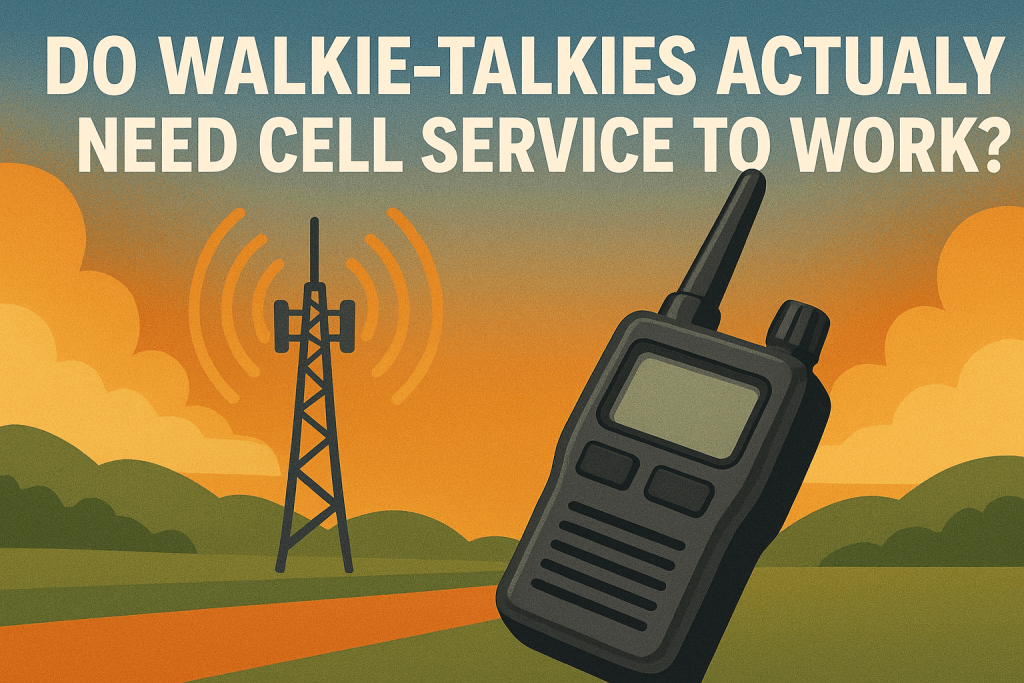Quick answer: No… but sometimes, yes.
Let’s get something out of the way—“walkie-talkie” is no longer a one-size-fits-all term. It covers everything from old-school analog radios used by campers to advanced push-to-talk devices that look like smartphones but act like radios.
So, do walkie-talkies need cell service?
The short version:
- Traditional walkie-talkies? Absolutely not.
- Modern LTE-enabled push-to-talk radios? They can use cell service—and that’s actually the point.
If that sounds confusing, stick with us. It’s not just tech-speak—it’s about understanding which type of device fits your situation.

Traditional Walkie-Talkies: 100% Independent, 100% Limited
The classic walkie-talkie doesn’t rely on any infrastructure. No towers. No satellites. No Wi-Fi. You push the button, and it transmits radio waves directly to another device on the same channel and frequency.
Pros:
- Works anywhere (as long as you’re in range)
- No cell service required
- No subscription fees or networks to maintain
Cons:
- Range is limited by terrain, buildings, and line-of-sight
- Typically maxes out at a few miles (realistically much less)
- No location tracking or advanced features
In other words, you can use them off the grid—but only if your team is nearby. Great for hiking. Not so great for coordinating between job sites 20 miles apart.
LTE-Enabled Push-To-Talk Devices: Powered by Cell Towers (On Purpose)
Here’s where the confusion starts. Some modern walkie-talkie-style devices are built to run over LTE networks—the same cell towers that power your smartphone.
These aren’t your grandpa’s radios. They’re hybrid tools that combine the instant communication of walkie-talkies with the nationwide coverage of cell networks.
Pros:
- Talk to anyone, anywhere there’s LTE or Wi-Fi
- Clear, digital audio with no static
- GPS, messaging, and even video capabilities
- Often no FCC licensing required
Cons:
- Requires cell service or Wi-Fi to function fully
- Usually needs a data subscription
- May not work in off-grid environments without a fallback radio mode
So, do these types of walkie-talkies need cell service? Yes—for their advanced features. But many can also switch to traditional radio modes when LTE isn’t available, giving you the best of both worlds.
But Wait—What About Wi-Fi?
Some LTE-based radios can also run on Wi-Fi. That means even if you’re in a building or facility with zero cell signal but solid wireless coverage, your device still works like a charm.
This is especially useful for:
- Warehouses
- Hospitals
- Event venues
- Large campuses
No cell towers nearby? No problem—as long as there’s a network.
What If You Want Full Freedom?
If you’re the type that works off the grid, in remote areas, or across unpredictable terrain, then you’ll want one of the following:
- Standard walkie-talkies with UHF/VHF frequencies for short-range, infrastructure-free communication.
- LTE-capable radios with a fallback mode, so you get long-range coverage when service is available—and old-school radio functionality when it’s not.
This combo gives you range and reliability, without being dependent on one single type of connection.
Final Thought: It’s Not About the Signal—It’s About the Scenario
The question isn’t whether a walkie-talkie needs cell service. It’s what you need from your walkie-talkie.
- Working a remote trail crew? Go analog.
- Coordinating mobile teams across states? LTE push-to-talk is your friend.
- Managing a building with thick concrete walls but great Wi-Fi? Look for hybrid devices.
There’s no one-size-fits-all anymore. But with the right setup, your team stays connected—whether you’ve got five bars, or zero.